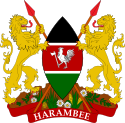- Constitutional Reforms in Kenya
-
Kenya 
This article is part of the series:
Politics and government of
Kenya
Contents
History of Reform
Constitutional Reform in Kenya has been a major issue since Kenya gained independence. The highlights of the evolution of Kenya's constitution can be highlighted by the following events:
- 1963 - Kenya gains independence and adopts a multi-party parliamentary system where Jomo Kenyatta was installed as Kenya's first Prime Minister.1963 Constitution of Kenya
- 1964 - Kenya abolishes the Prime Minister position and Jomo Kenyatta becomes Kenya's first President.
- 1966 - Federal assemblies at provincial level scrapped. Senate dissolved and its members absorbed into National Assembly.
- 1976 - Constitutional amendment enabling president to pardon politicians barred from contesting elections over electoral malpractices. Opposition to amendment the leads to the arrest and imprisonment of Philomena Chelagat Mutai and George Anyona.
- 1983 - Multi-partism is abolished making Kenya a single party state with KANU as the ruling party. This was followed by the mlolongo system where secret-ballots were no longer used.
- 1991 - President Moi in December 1991 at a KANU delegates meeting at Kasarani Stadium, repealed Section 2A of the constitution, thereby making Kenya a multi-party state. The change enabled the introduction of term limits to the Presidency.
- 2000 - Commission for Constitutional Reform of Kenya was setup by President Moi and Prof Yash Pal Ghai was installed as its Chairman to spearhead Kenya's first major constitutional reform.
- 2005 - President Kibaki campaigns and pushes for a new constitution to be voted on in the November referendum. Mr. Odinga had earlier pushed for the Bomas Draft to be adopted, but was rejected by the Government and instead the Government pushed for the Wako Draft to be adopted. The referendum was defeated when the majority voted NO in the referendum election.
- 2008 - In March 2008, the National Assembly of Kenya passed the Nation and Reconciliation Accord Act that introduced a temporary change to the constitution introducing the position of Prime Minister and two Deputy Prime Ministers.
- 2009 - Parliament prioritizes constitution reform through Agenda #4. Deliberations on how this reforms will be tackled will be discussed in the second session of the 10th Parliament that began in April 2009.
Previous Proposed Constitution Drafts and processes
- 2003-2005 Bomas Draft - Proposed transferring most of the powers of the office of the President elected by the people to the Prime Minister that would be elected by Parliament. In addition, there would have been checks on executive appointments. The PM would nominate MP's to become Cabinet ministers, the President would then appoint them. All appointments would require up and down votes by a members of the Senate.
- 2005 Wako Draft - Was a modified version of the current constitution but got rid of 25% requirement in general elections that requires the winner in the Presidential election to have 25% in at least 5 provinces. The winner would also have to get more than 50% of the vote, else an instant re-run would occur.
- 2000-2004 Yash Pal Ghai's Draft -
- Post-2005 Minimal Constitution Reform option - proposed by Prof. Yash Pal Ghai after the failed referendum. He's proposal suggests that for political and practical reasons, changing Kenya's constitution is a complex process and the best way to go around it would be to do it in small phases as opposed to immediate and complete overhaul of the current system.
Recent Proposed Constitution Drafts and processes
- March 2009 - Agenda #4 - The 10th Parliament started this off by creating a Committee of Experts on Constitutional Reform to gather views from the public, deliberate on contentious issues and come up with a draft of the new constitution.
- October, 2009 - The Committee of Experts concluded their work on creating a draft and announced that they would be releasing it on November 17, 2009 [1]
Harmonized Constitution of Kenya Draft, 2009
Main article: Harmonized Draft Constitution of Kenya, 2009The harmonized draft constitution written and proposed by the Committee of Experts was released on November 17, 2009 and has the following highlights[2] :
- Transfer of executive authority from the President to the Prime Minister position who will be the Head of Government.
- President will be the Head of State and maintain a more ceremonial role.
- Prime Minister will be the Head of Government and will be the head of the party/coalition with a majority in Parliament - He will nominate Ministers to the Cabinet.
- Half of the Ministers in cabinet can be nominated from non-MPs.
- The total number of MP's will be increased from 222 to 295.
- An upper house, a Senate, will be introduced to represent the regions - the total number of Senators will be 113.
- Devolution to the provincial level - current 8 provinces will be now referred to as regions.
- The 8 regions/provinces will be subdivided into counties - There will be a total of 70 counties and will each be headed by executives.
- Nairobi Province will become a region and have a popularly elected Mayor as opposed to having the City councilors elect the Mayor.
- Retention of Kadhi court system as it is in the current constitution.
See also
- Constitution of Kenya
- Proposed Constitution of Kenya, 2010
- 10th Kenyan Parliament
References
- ^ "Kenya draft constitution due next week", Capital FM, November 12, 2009
- ^ "Kenya unveils draft Constitution", Capital FM, November 17, 2009
Categories:- Politics of Kenya
- Kenyan law
Wikimedia Foundation. 2010.
